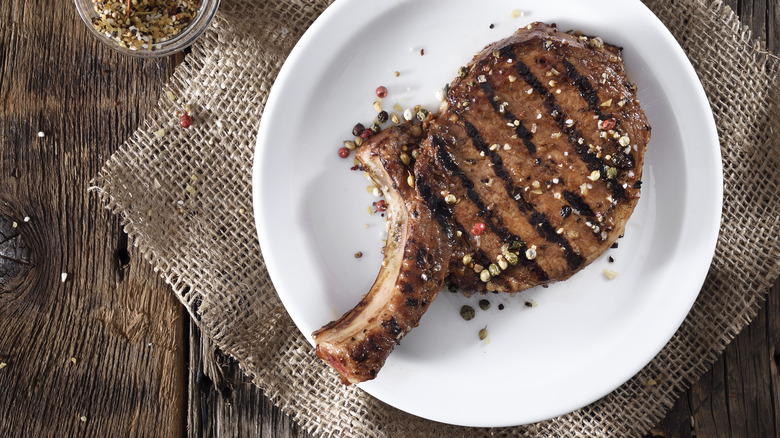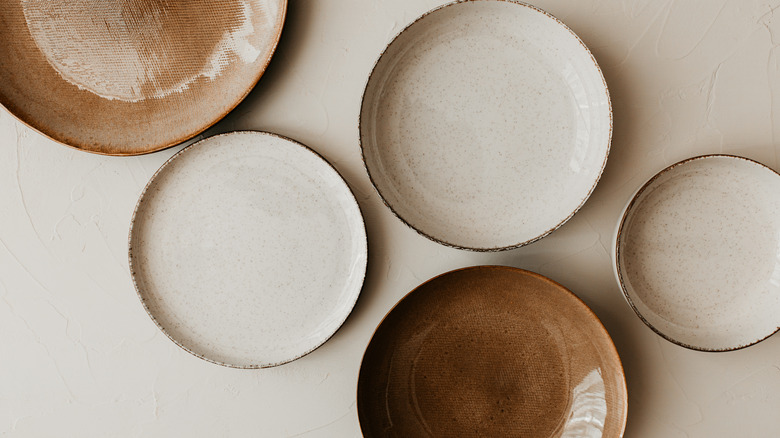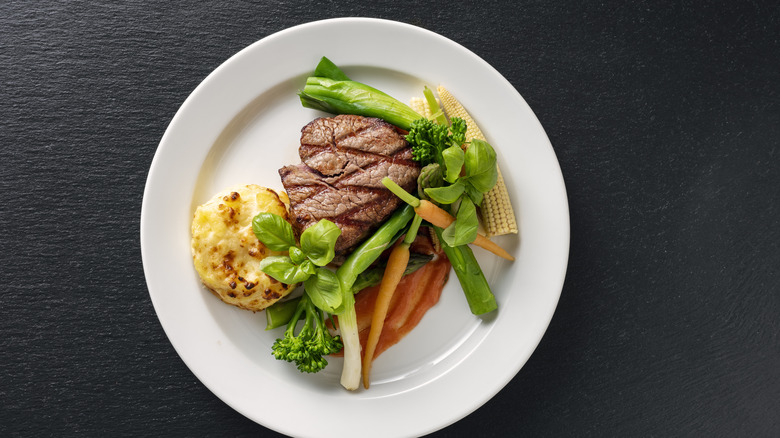The Easiest Tip For A Better Steak Dinner Is To Heat Up Your Plate
Steak. It's what's for dinner. But as all-American and ubiquitous as the protein may be in so many homes and cuisines, it can also be pricey, and thus high stakes (pun intended) to get it right. While there are so many tips about how to make the best beef preparation possible, there is one shockingly simple, entirely accessible strategy that will make sure your meat is enjoyed the way you intended. And that is to heat up your plate.
Restaurants usually know this secret well, and intuitively leverage the science behind temperature transfer, and the process called conduction. This happens when two objects come into contact and exchange thermal qualities as the kinetic energy of heat sends vibrations between them. This process is one-directional: heat reliably moves from areas that are hotter to the cooler ones. That means that when a plate is lower than the temperature of the food you place upon it, the surface will hungrily grab up some of that heat away from the meal you worked so hard to prepare. Heating your plate will help mitigate that transfer, and ensure that your plate won't steal heat from your steak.
Selecting and heating plates
To leverage this trick and make the most of this scientific fact is a cinch. Simply flip the switch on your oven, and set it to the base temperature (usually around 150 to 170 degrees Fahrenheit), and then place your plates inside for a few minutes. Alternatively, you can opt for a higher temperature (around 325 to 400 degrees Fahrenheit) and cut the warming time down to around 30 or 40 seconds. Other possibilities include nuking the plates in the microwave for a few seconds, or nestling a stack between burners on a stovetop when the oven is in use for other purposes. And, always be sure to handle them with oven mitts or a towel.
As far as plates that are safe for this purpose, the super low temps shouldn't put many materials at risk. However, a few types will be best suited, particularly if you plan to use a higher temperature. Metal, ceramic, cast iron, and glass are all on the safer side, and you can even opt for an eco-conscious option with palm leaf plates that can withstand 350 degrees Fahrenheit for about 45 minutes.
It's a good idea to research the breaking points of these options just so you can be sure that they'll suit your purpose, and most will have a label on the bottom with the details you need to know — like specifying if they're oven-safe. You'll always want to avoid plastic, wood, styrofoam, and paper entirely, or any ceramic plates with patterns or designs that might chip or flake off.
Put more on the plate
Now that you have a perfectly cooked steak on an appropriately warm plate, you can turn your attention toward accompaniments and garnishes to make it look appealing, too. For as delicious as steak can be, it isn't exactly the most colorful food on the pyramid. Reach for vibrant veggies and striking sauces to help give your presentation a little more visual range.
There are so many ways to go about elevating your steak presentation, including bringing edible add-ons like fried herbs (think sage or rosemary), or truly irresistible varieties of compound butter, which add both aromatics and flavor as they melt over a warm cut of beef. A savory mushroom cream sauce is classic, while a vibrant avocado crema adds a fun, falvorful green pop to the plate. For a little veggie variation, go for bright complements like a beet and radicchio salad, which won't wilt when set on a warm plate.
To flavor your steak, you can rely on a simple rub to bring a major boost, with anything from cayenne for a kick to toasty fennel seeds for a steak rub. A punchy, vinegary mustard sauce makes for an ideal complement to just about any kind of steak dinner, and when in doubt, pile on the French fries for a steak frites kind of night. With a nice, toasty surface, your beef will be right at home.


